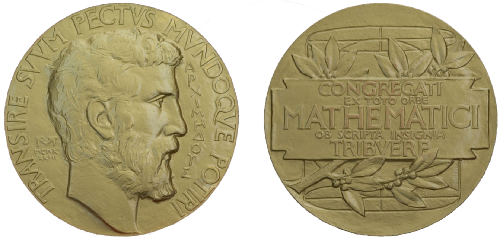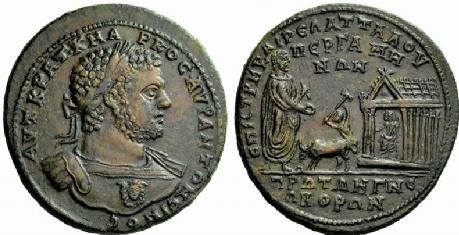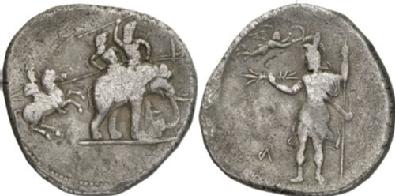All 3 entries tagged Medallion
No other Warwick Blogs use the tag Medallion on entries | View entries tagged Medallion at Technorati | There are no images tagged Medallion on this blog
September 02, 2014
Archimedes' Theorem of the Sphere & Cylinder: Martin Hairer's Fields Medal & Immortality of Science
Numismatics does not only include the study of coins but also a range of coin-like objects, such as medals, tokens and other related items. This month's 'coin of the month' is actually a medal: the Fields medal, displayed on the University's main home page, awarded by the International Mathematical Union to Martin Hairer, professor in mathematics at Warwick University, for his outstanding achievements in stochastic partial differential equations (SPDEs). This recognition is of highest international renown and the University can be proud of such a scholar.
As a classicist I am light-years away from understanding SPDEs and adequately appreciating his dazzling theory of regularity structures. Yet, there is a quote from Hairer which is, I believe, appealing to classicists: 'One advantage of mathematics is the immortality. Theorems that were proven 2,000 years ago are still true...' This is food for thought within our own disciplines of Classics and Ancient History, including numismatics. Would we claim immortality for our field of research as well? My answer is 'yes', and the medal itself provides an excellent example to underpin this affirmation.
The obverse depicts Archimedes (in a post-World War I artistic style) and the Greek legend ΑΡΧΙΜΕΔΟΥΣ (‘of Archimedes’) and the Latin legend TRANSIRE SVVM PECTVS MVNDOQVE POTIRI (‘Exceed above oneself and grasp the world’). The reverse shows a tablet (a tabula ansata) with the Latin inscription CONGREGATI / EX TOTO ORBE / MATHEMATICI / OB SCRIPTA INSIGNIA / TRIBVERE (‘Gathered from the entire world, Mathematicians have awarded (this medal) for outstanding writing’). The tablet is displayed on a laurel branch, and the branch is placed upon a background with Archimedes' theorem of the sphere and cylinder, a line drawing of a sphere inscribed in a cylinder. Archimedes had proven that both the volume and the surface area of the sphere were two-thirds that of the cylinder.

The fields medal awarded to Martin Hairer by the International Mathematical Union on 13 August 2014. The medal is in gold, and bears the monogram RTM, the signature of the artist Robert Tait McKenzie (1867-1938). The date is MCMXXXIII.
The medal has an impressive concentration of references to antiquity. Archimedes (c. 287-212 BC) was active in the Hellenistic period at the court of King Hieron II in Syracuse (275-215 BC) and is considered the greatest ancient mathematician. He died during the sack of Syracuse by the Romans in 212 BC, sadly killed by a Roman soldier according to Plutarch (Marcellus 19.4-5) when he was working out a problem involving circles. Plutarch (Marcellus 17.7) relates also that his tomb was adorned with his theorem of the sphere and cylinder and that, proud of his achievement, it was Archimedes himself who requested the theorem adorn his funerary monument.
With the Fields medal the community of modern-day mathematicians refers to one of their most famous forerunners. They define themselves in the present through the past, and by doing so they build up a foundation for the future. They are, by the way, not the first to go back to Archimedes or his tomb monument. The philosopher and statesman Cicero (106-43 BC) had already gone in search of the tomb and its theorem. He discovered it outside Agrigentum, overgrown by thorn bushes (Tusculum 5.23.64-65).
The laurel branch on the reverse, at the root of the word 'laureate', and the shape of the tablet are further references to antiquity. The laurel was awarded to winners of the Pythic games, and later on laurels in the form of wreaths were awarded to Roman victors in triumph, to poets, and to Christian martyrs.
Referring back to forerunners and their achievements is taking an example from earlier scholarship as a way of legitimatizing present and future research activities. It is also an act of humility by relativizing a single achievement. This is also expressed by the fact that the laureate's name is missing. According to the instructions of John Charles Fields, who established the award, the medal should not bear the name of an individual nor of a nation, and the legend had to be in Latin or ancient Greek. Moreover the medal was not only to be awarded for past achievement, but also to encourage future research. (As a matter of fact, the name of the recipient is engraved on the medal’s edge.)
To inscribe the present into the unlimited time-span between past and future means breaking up limits. This principle is as immortal as Archimedes’ theorem, and it makes ancient history, as well as history more generally, an immortal science. Immortality on the other hand stands in cruel contrast to the reality of human life. Immortality in science therefore responds to the human hope to transgress the limitations of being a human being and maybe to hope for eternal life.
This is expressed by the inscription on the obverse of the medal which is a quote from Marcus Manilius, a poet and astronomer of the first century AD: TRANSIRE SVVM PECTVS MVNDOQVE POTIRI—‘Go beyond oneself and grasp the world’ (Astronomica 4.392). This comes from a longer passage on the signs of the zodiac where the author advocates the arduous study of astronomic science as a way of seeking God: ‘Quod quaeris, deus est’ (Astronomica 4.390).
The desire to create a tomb monument ascribed to Archimedes is likewise connected with mortality and immortality. And the medal itself is a small monument. It is not issued, like coins, in big masses, but struck for the laureates only. It is not spent like money, but carefully kept aside or displayed. It is not overgrown by bushes like a stone monument, but genteelly adorns by the recipient.
 This month’s coin was chosen by Suzanne Frey-Kupper, Associate Professor of Numismatics and Classical Archaeology at the Department of Classics and Ancient History at the University of Warwick. She works on Greek, Punic, and Roman coinage from the Western Mediterranean and the North-Western provinces. She has published the coin finds from many major archaeological sites, in Italy and Sicily, Malta, Cossyra, Carthage and North of the Alps. With N.K. Rutter and J. Morcom she is currently preparing the volume Sicily and the Adjacent Islands of Historia Numorum.
This month’s coin was chosen by Suzanne Frey-Kupper, Associate Professor of Numismatics and Classical Archaeology at the Department of Classics and Ancient History at the University of Warwick. She works on Greek, Punic, and Roman coinage from the Western Mediterranean and the North-Western provinces. She has published the coin finds from many major archaeological sites, in Italy and Sicily, Malta, Cossyra, Carthage and North of the Alps. With N.K. Rutter and J. Morcom she is currently preparing the volume Sicily and the Adjacent Islands of Historia Numorum.
This summer she was a visiting scholar of the Summer Seminar at the American Numismatic Society (ANS) in New York where she was awarded a medal (shown below) by the New York Numismatic Club with a similar reverse to the medal described above. On its obverse is Henry Grunthal (1905-2001). Born in Cologne (Germany), son of numismatist and medal publisher Hugo Grunthal, Henry Grunthal emigrated to the United States in 1938, joined the ANS in 1953 and advanced to the position of curator of European and modern coins. His work focused on Carolingian coinage and on the coinage of Peru. He studied archaeology and art history Berlin, Jena and in Paris, and numismatics under Kurt Regling (1876-1935) in Berlin and Behrendt Pick (1861-1940) in Gotha. The latter was a student of Theodor Mommsen (1817-1903) and later worked with Regling on Mommsen’s ‘Griechisches Münzwerk’ (Die antiken Münzen Nord-Griechenlands. Dacien und Moesien, 2 vols, Berlin 1898 and 1910). Both Pick and Mommsen were, for a short period, professors in Zurich, where Suzanne Frey-Kupper studied Classical Archaeology and lectured for a few years before joining Warwick in 2011.

September 01, 2013
A bronze medallion depicting Caracalla and Asclepius from Pergamum, AD 211–217 (AE 46.14g)
(Coin of the Month February 2013)
In c.AD 214 Caracalla visited the city of  Pergamum as part of his tour around Asia Minor. Ancient historians state that the reason for this visit was because he sought healing and relief from dreams in which he was being chased by his father Septimus Severus and brother Geta, whom he was accused of murdering. As the healing god of antiquity, Asclepius was a logical choice to supplicate for salvation. This medallion is part of a series which was minted by Pergamum in AD 211-217. The series documents the emperor’s advent and his ritual movements through the city. This medallion shows Caracalla supplicating Asclepius in front of his temple. In between the god and the emperor stands a bull waiting to be sacrificed to the god and an attendant with a raised axe. This medallion is especially important as it shows the significance the emperor attached to worshipping Asclepius and the belief that this god could save him from his torment. It also shows the importance the city attached to the emperor’s visit as the polis struck these issues and also issued another series commemorating the visit some years later. This medallion also shows the advantages of imperial benefaction upon a city as the coin’s legend mentions that Pergamum was the first who was ‘three times neokoros’ in Asia Minor. This term was used to indicate a city which had a temple of the imperial cult and Pergamum was the first in the region to have three temples of emperors. Other coins from this series show Asclepius and Caracalla sharing a temple, a practise not uncommon in Asia Minor, again indicating Caracalla’s patronage of this god.
Pergamum as part of his tour around Asia Minor. Ancient historians state that the reason for this visit was because he sought healing and relief from dreams in which he was being chased by his father Septimus Severus and brother Geta, whom he was accused of murdering. As the healing god of antiquity, Asclepius was a logical choice to supplicate for salvation. This medallion is part of a series which was minted by Pergamum in AD 211-217. The series documents the emperor’s advent and his ritual movements through the city. This medallion shows Caracalla supplicating Asclepius in front of his temple. In between the god and the emperor stands a bull waiting to be sacrificed to the god and an attendant with a raised axe. This medallion is especially important as it shows the significance the emperor attached to worshipping Asclepius and the belief that this god could save him from his torment. It also shows the importance the city attached to the emperor’s visit as the polis struck these issues and also issued another series commemorating the visit some years later. This medallion also shows the advantages of imperial benefaction upon a city as the coin’s legend mentions that Pergamum was the first who was ‘three times neokoros’ in Asia Minor. This term was used to indicate a city which had a temple of the imperial cult and Pergamum was the first in the region to have three temples of emperors. Other coins from this series show Asclepius and Caracalla sharing a temple, a practise not uncommon in Asia Minor, again indicating Caracalla’s patronage of this god.
 This month’s coin was chosen by Ghislaine van der Ploeg, a second year PhD student. Ghislaine’s research focusses on the cult of Asclepius and its dissemination. Coins, as well as inscriptions, art, and architecture are vital in this, as each dedication gives a unique perspective on the ways in which the cult spread and the factors which were responsible for this.
This month’s coin was chosen by Ghislaine van der Ploeg, a second year PhD student. Ghislaine’s research focusses on the cult of Asclepius and its dissemination. Coins, as well as inscriptions, art, and architecture are vital in this, as each dedication gives a unique perspective on the ways in which the cult spread and the factors which were responsible for this.
(Coin image above reproduced courtesy of Numismatica Ars Classica AG [Auction 54, lot 504])
The 'Porus Medallion', a silver decadrachm with an image of Alexander the Great
(Coin of the Month, December 2012)
In 326 BC Alexander the Great and his army reached India  where they encountered the army of the Hindu king Porus. At the River Hydaspes Alexander managed to defeat his opponent in a closely fought battle across the monsoon-swollen river. Despite this victory Alexander’s army would advance little further into India. Daunted by the skill and number of the native people and terrified by their elephants, the Macedonians mutinied and demanded to return westwards, to which Alexander eventually agreed. After many trials and tribulations the Macedonian army ultimately returned to Babylon where Alexander would live out the last few months of his life before dying suddenly and mysteriously on the 10th June 323 BC.
where they encountered the army of the Hindu king Porus. At the River Hydaspes Alexander managed to defeat his opponent in a closely fought battle across the monsoon-swollen river. Despite this victory Alexander’s army would advance little further into India. Daunted by the skill and number of the native people and terrified by their elephants, the Macedonians mutinied and demanded to return westwards, to which Alexander eventually agreed. After many trials and tribulations the Macedonian army ultimately returned to Babylon where Alexander would live out the last few months of his life before dying suddenly and mysteriously on the 10th June 323 BC.
The “Porus Medallions” or “Franks Medallion” (named after the donor of the first example of the coin to the British Museum) was discovered in modern Afghanistan in the late 19th century. The obverse shows a cavalryman, identified as a Macedonian by his Phrygian-style helmet and characteristic long lance (or sarissa), charging at an elephant with two warriors mounted on its back. The reverse shows another Macedonian horseman, or possibly the same one, this time standing and being crowned by a winged Victory but still wearing his distinctive helmet. However this Macedonian is carrying what could either be a sarissa or a royal sceptre in his left hand, and more importantly in his right hand he holds the thunderbolt of Zeus. The coin is obviously a reference to the Macedonian victory at the Hydaspes and it is just as clear that the Macedonian figure is intended to be Alexander himself, both through his wielding of the thunderbolt of his ancestor Zeus and through the distinctive white plumage which Plutarch tells us the king wore on either side of his helmet. The standing figure mounted on the elephant and brandishing a spear on the obverse has been identified as Porus because of the figure’s height. Porus is described in almost all primary sources as extremely tall, sometimes as over 2.1 metres or 7 feet tall, and the height of the figure on the elephant would certainly tally with those measurements. On some examples of the medallion it is even possible to discern the foot of the rider behind the elephant about halfway up its leg, adding further emphasis to the prodigious height of the man.
The depictions of Alexander and Porus on the medallions are interesting, but it is the dating of the coin that makes it truly fascinating. It is almost impossible to tell exactly when the coin was minted due to the lack of any kind of legend. However the coin has been approximately dated to the very end of Alexander’s lifetime, minted in Babylon either shortly before or shortly after his death in 323 BC. If we take the date before Alexander’s death and accept that it is Alexander himself featured on the reverse, then this series of coins is remarkable. It would represent not only the sole surviving depiction of Alexander the Great produced in his lifetime, but would be the earliest known image of an identified living person on coins. This coinage provides not only an intriguing mystery for numismatists but could also provide remarkable insight into the mindset of Alexander and his views on his own divinity. They also demonstrate, through the use of an image of a living person as a type, the development of coin types as a form of propaganda which would continue to be used throughout history.
![]() This month’s coin was chosen by Nathan Murphy, a final year Ancient History and Classical Archaeology undergraduate. Nathan’s research interests include the social and economic function of coinage and the spread of money in the ancient world. His dissertation is focussing on the monetisation of the Roman countryside between the first and fourth centuries AD, looking at the levels of monetary use among rural populations in Roman Egypt, Syria and Britain.
This month’s coin was chosen by Nathan Murphy, a final year Ancient History and Classical Archaeology undergraduate. Nathan’s research interests include the social and economic function of coinage and the spread of money in the ancient world. His dissertation is focussing on the monetisation of the Roman countryside between the first and fourth centuries AD, looking at the levels of monetary use among rural populations in Roman Egypt, Syria and Britain.
(Coin image above reproduced courtesy of Baldwin's Auctions Ltd, New York Sale XXVII, 304).
 Clare Rowan
Clare Rowan

 Please wait - comments are loading
Please wait - comments are loading

 Loading…
Loading…

